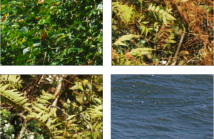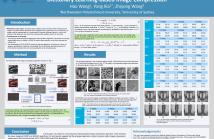- Read more about Filling the GAPs: Reducing the Complexity of Networks for Multi-attribute Image Aesthetic Prediction
- Log in to post comments
Computational aesthetics have seen much progress in recent years with the increasing popularity of deep learning methods. In this paper, we present two approaches that leverage on the benefits of using Global Average Pooling (GAP) to reduce the complexity of deep convolutional neural networks. The first model fine-tunes a standard CNN with a newly introduced GAP layer. The second approach extracts global and local CNN codes by reducing the dimensionality of convolution layers with individual GAP operations.
poster.pdf
- Categories:
 26 Views
26 Views- Read more about 4K-UHD Real-time HEVC Encoder with GPU Accelerated Motion Estimation
- Log in to post comments
- Categories:
 32 Views
32 Views
- Read more about ANALYSIS/SYNTHESIS CODING OF DYNAMIC TEXTURES BASED ON MOTION DISTRIBUTION STATISTICS
- Log in to post comments
Here we present improvements to a dynamic texture synthesis approach which is based on motion distribution statistics, able to produce high visual quality of synthesised dynamic textures. The aim is to recreate synthetically highly textured regions like water, leaves and smoke, instead of processing them with a conventional codec such as HEVC. The method involves two steps: analysis, where motion distribution statistics are computed, and synthesis, where the texture region is synthesized. Dense optical flow is utilized for estimating the random motion of dynamic textures.
- Categories:
 3 Views
3 Views- Read more about Fast Template Matching for Intra Prediction
- Log in to post comments
- Categories:
 7 Views
7 Views- Read more about Progressive Communication for Interactive Light Field Image Data Streaming
- Log in to post comments
Light field (LF) imaging captures multiple intensities and directions of light per pixel during acquisition in a 3D scene, so that novel images of different viewpoints or focal points can be synthesized. However, transmitting all LF data before viewer observation incurs a large startup delay. To avoid such delay, we propose a new interactive LF streaming framework, where a client periodically requests viewpoint images, and in response a server synthesizes and transmits each requested image as a carefully chosen sparse linear combination of sub-aperture images.
- Categories:
 27 Views
27 Views- Read more about INTEGRATING THOR TOOLS INTO THE EMERGING AV1 CODEC
- Log in to post comments
Over recent years there have been several efforts which aim to standardise a royalty-free video codec, such as Thor developed by Cisco, and AV1 developed by the Alliance for Open Media. In this paper we discuss how some compression tools in Thor were integrated into the emerging AV1 codec aiming to increase compression efficiency as well as to decrease computational complexity.
- Categories:
 102 Views
102 Views- Read more about GPGPU Implementation of VP9 in-loop deblocking filter and improvement for AV1 codec
- Log in to post comments
- Categories:
 112 Views
112 Views
- Read more about Dictionary Learning-based Image Compression
- Log in to post comments
Dictionary learning based image compression has attracted a lot of research efforts due to the inherent sparsity of image contents. Most algorithms in the literature, however, suffer from two drawbacks. First, the atoms selected for image patch reconstruction scatter over the entire dictionary, which leads to a high coding cost. Second, the sparse representation of image patches is performed independently from the quantization of sparse coefficients, which may result in a sub-optimal solution.
- Categories:
 22 Views
22 Views- Read more about CODING BLOCK-LEVEL PERCEPTUAL VIDEO CODING FOR 4:4:4 DATA IN HEVC
- Log in to post comments
There is an increasing consumer demand for high bit-depth 4:4:4 HD video data playback due to its superior perceptual visual quality compared with standard 8-bit subsampled 4:2:0 video data. Due to vast file sizes and associated bitrates, it is desirable to compress raw high bit-depth 4:4:4 HD video sequences as much as possible without incurring a discernible decrease in visual quality. In this paper, we propose a Coding Block (CB)-level perceptual video coding technique for HEVC named Full Color Perceptual Quantization (FCPQ).
- Categories:
 5 Views
5 Views- Read more about Low Complexity Video Coding Based on Spatial Resolution Adaptation
- Log in to post comments
In this paper, a novel spatial resolution adaptation approach for video compression is proposed. Its ability to dynamically apply downsampling to frames exhibiting low spatial detail delivers improved rate distortion performance, together with a reduction in computational complexity of the encoding process. This method is based on an experimental investigation of the dependence between the QP threshold, which determines when to encode lower resolution frames, and the distortion obtained after downsampling/upsampling.
- Categories:
 24 Views
24 Views